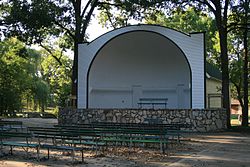
Maquoketa Caves State Park is a state park of Iowa, United States, located in Jackson County. It stands northwest of the city of Maquoketa. In 1991 111 acres (45 ha) on the east side of the park were listed as a historic district on the National Register of Historic Places.

Eagle Point Park is a 164-acre (0.66 km2) public park located in the northeast corner of the city of Dubuque, Iowa, United States. Eagle Point is mostly situated on a bluff that overlooks the Mississippi River and the Lock and Dam No. 11. The park is owned and operated by the city of Dubuque. It was listed as a historic district on the National Register of Historic Places in 2017. At the time of its nomination it contained 34 resources, which included 14 contributing buildings, seven contributing sites, five structures, five objects, two non-contributing buildings, and two non-contributing structures.
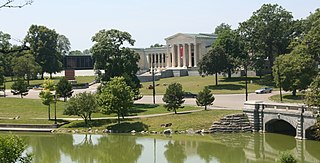
Delaware Park–Front Park System is a historic park system and national historic district located in the northern and western sections of Buffalo in Erie County, New York. The park system was designed by Frederick Law Olmsted and Calvert Vaux and developed between 1868 and 1876.

The Oleson Park Music Pavilion, also known as the Karl King Bandshell, is located in Fort Dodge, Iowa, United States. The pavilion is associated with Karl King, a famed composer for concert and military bands, who advocated for its construction. It was designed by Henry L. Kamphoefner, a Sioux City architect at that time, who had previously designed the Grandview Park Music Pavilion in Sioux City. It was built as a Works Progress Administration (WPA) project. The WPA paid for 85% of its construction, with the City of Fort Dodge paying the rest. The poured concrete structure was built in a Modernist style with Art Deco overtones. It rises to a height of 36 feet (11 m), and it is known for its acoustical excellence. The pavilion replaced a bandstand that was built in the 1920s in the city square. It was dedicated to King in 1976, and listed on the National Register of Historic Places in 2003.

The Vander Veer Park Historic District is a historic district in Davenport, Iowa, United States, that was listed on the National Register of Historic Places. Over its 70.8-acre (287,000 m2) area, in 1985 it included 66 contributing buildings, two contributing structures, one contributing site, and one contributing object.
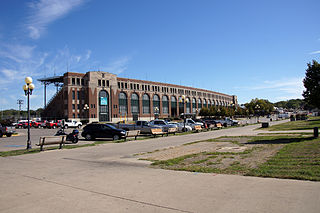
The Iowa State Fairgrounds is located on the east side of Des Moines, Iowa. It annually hosts the Iowa State Fair in late summer. The state fair was begun in Iowa in 1854 and the current fairgrounds were established in 1886. The fairgrounds were listed as an historic district on the National Register of Historic Places in 1987 as the Iowa State Fair and Exposition Grounds.

The W.D. Petersen Memorial Music Pavilion, commonly referred to as the LeClaire Park Bandshell, is located on Beiderbecke Drive in LeClaire Park, Davenport, Iowa. It was listed on the National Register of Historic Places in 1983 and on the Davenport Register of Historic Properties in 1993.

LeClaire Park is a public park located along the Mississippi River in downtown Davenport, Iowa, United States. It is situated between two other riverfront parks: Centennial Park on the west and River Heritage Park, a new park that is being developed to the east. The 400-acre (1.6 km2) park includes monuments, a bandshell, a baseball stadium and it is one of the terminal points for the Davenport Skybridge. The Riverfront Parkway pass through the park. Other features of the park include picnic shelters, horseshoe pits and river access for fishing. Moored off the park’s levee is a riverboat casino.

The John K. Voorhees House is a historic building located northwest of Oskaloosa, Iowa, United States. A native of Warren County, Ohio, Voorhees settled in Mahaska County in 1853. He owned 400 acres (160 ha), and was considered a leading farmer in the county. He was known for his horses and Black Angus cattle. Voorhees had this house built in 1871, and he supervised the work that was done by masons and carpenters. It is a combination of the Italianate and Second Empire styles. The 2½-story, brick structure follows a T-plan. It features a mansard roof, bracketed eaves, limestone quoins on the front, brick quoins on the back, and a full sized wrap-around front porch. The east section of the original porch and the balustrades on top had been removed. They have subsequently been recreated. The house was listed on the National Register of Historic Places in 1982.

Pilot Knob State Park is located southeast of Forest City, Iowa, United States. Founded in 1923, it is one of the oldest state parks in Iowa. Between 1990 and 1995 one area was named nationally recognized historic district and five structures were individually listed on the National Register of Historic Places.

Lacey-Keosauqua State Park is located southwest of Keosauqua, Iowa, United States. The park is located along the Des Moines River in Van Buren County. First dedicated in 1921, it is the largest state park in size in Iowa. In 1990, three areas were named nationally recognized historic districts and listed on the National Register of Historic Places.

Le Mars Municipal Park and Golf Course Historic District is a nationally recognized historic district located in Le Mars, Iowa, United States. It was listed on the National Register of Historic Places in 2001. At the time of its nomination the district consisted of 25 resources, including 11 contributing buildings, one contributing site, four contributing structures, eight non-contributing buildings, and one non-contributing structure.

Wapsipinicon State Park is located south of Anamosa, Iowa, United States. The 394-acre (159 ha) park is along the sandstone and limestone bluffs of the Wapsipinicon River, from which it derives its name. It is one of the oldest state parks in Iowa, and it was listed as a historic district on the National Register of Historic Places in 2014.
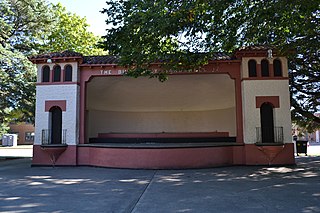
Estes Park Band Shell is a historic building located in Iowa Falls, Iowa, United States. Planning and construction of the band shell were a community project that began in 1931. They engaged Iowa Falls native L.L. Klippel to design the structure, and N.F. Guernsey of Sioux City, Iowa to landscape Estes Park. Completed later in the year, the Mission/Spanish Revival structure features two bell towers with round arch balconies that flank the proscenium arch. There is a cement basement that houses rehearsal space. The walls are stucco, and the structure is capped with a tiled hip roof with bracketed eaves. Over the years the band shell has hosted concerts, dances, and a variety of entertainment activities. Labor unions and political parties have held rallies here. Wendell Willkie spoke here when he ran for president in 1940. The band shell was listed on the National Register of Historic Places in 1993.

The Mason City Public Library is located in Mason City, Iowa, United States. The building that was funded by Andrew Carnegie, and is now an office building, was listed on the National Register of Historic Places in 1989. It was included as a contributing property in the Mason City Downtown Historic District in 2005.

The Grandview Park Music Pavilion is a historic structure located in Sioux City, Iowa, United States. The Monahan Post Band raised money in 1930 to build a modest music shell in the park. Construction was already underway when the park's neighbors objected to the design. The project was put on hold as the band raised more money and sought a more suitable design. After President Franklin D. Roosevelt created the Civil Works Administration (CWA) in 1933, the city applied to have the new music shell included in Sioux City's projects. Henry L. Kamphoefner, an unknown Sioux City architect at that time, drew up the plans for the structure. The sculptural plaques on the front of the pavilion were designed by Herschel Elarth. The CWA approved the project on February 26, 1934 as CWA Project Number 217. The construction project required 52 tons of reinforcing steel, 4,200 bags of Portland cement, and 300 bags of white cement, and it was completed on October 17, 1934. Seating was constructed for 5,000 in the natural amphitheater. The pavilion was built using $47,436 from Federal Relief funds and $3,800 in materials from the city. It was dedicated in the spring of 1935. The Monahan Post Band continued to play here until 1948, when they became the Sioux City Municipal Band. They continue the summer-time tradition. The music pavilion was listed on the National Register of Historic Places in 2011.

Bandshell Park, also known as City Park and Music Pavilion, is located in Ames, Iowa, United States. It is a nationally recognized historic district that was listed on the National Register of Historic Places in 1999. At the time of its nomination it consisted of six resources, which included one contributing building, one contributing site, two contributing structures, one contributing object, and one non-contributing object. The park, located to the east of the central business district, was gift to the city in 1884 from the C&NW Land Company. The full city block was the first park established in Ames.
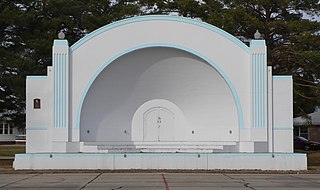
The Athletic Park Band Shell in Plainview, Nebraska was designed and built during 1939 to 1942. Also known as Plainview Band Shell, it was listed on the National Register of Historic Places in 1992.

East Park is a recreational park located in Mason City, Iowa, United States. It was listed as a historic district on the National Register of Historic Places in 2014. At the time of its nomination it contained 21 resources, which included three contributing buildings, one contributing site, five structures, seven non-contributing buildings, and five non-contributing structures. It contains 57.6 acres (23.3 ha) of land along the Winnebago River. The park features picnic areas, a 9-hole disc golf course, three tennis courts, volleyball court, basketball courts, fishing, a sledding hill, playgrounds including the Prairie Playground, a 2.08-mile (3.35 km) hard surface trail system, a band shell and a gazebo.

Elmwood-St. Joseph Municipal Cemetery is located in Mason City, Iowa, United States. It was listed as a historic district on the National Register of Historic Places in 2018.
